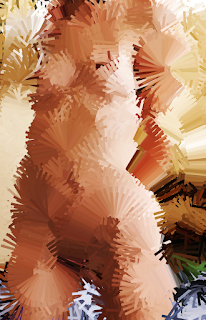Code15 : Machine Learning Memories
Where algorithms meet nostalgia, desert walks become digital dreams, and family resemblances reveal themselves through code
Desert Days at Brahman.ai
Earlier this year, I did a residency at Brahman.ai that transformed my understanding of machine learning. Beyond the technical skills gained, there was something magical about the rhythm of the place—how everyone would stop working each evening to watch the sunset, either from the beach or while unicycling through the desert (a skill I admittedly never mastered).
These sunset rituals became the raw material for some of my favorite ML experiments. Footage of me strolling through the desert or chasing a train took on new dimensions when processed through various algorithms. The original moments were beautiful, but watching them transform through computational interpretation created this fascinating dialogue between memory and machine.
Sometimes algorithms don't just process our experiences—they offer new ways of remembering them.
My daily TouchDesigner sketches from this period attempted to create watercolor-like effects from these desert wanderings. I'm not entirely satisfied with the results—they lack the organic unpredictability of actual watercolors—but the journey of experimentation was valuable regardless. There's something honest about sharing work that doesn't quite reach your vision; it makes the occasional successes more meaningful.
Faces in the Machine: Family Resemblance Experiments
Recently, someone mentioned I look like my mother—one of those observations that seems obvious to others but surprising to yourself. This sparked an idea to explore family resemblances through dataset interpolation, allowing algorithms to find and visualize the genetic threads connecting us.
The results were uncanny—not just in highlighting similarities I recognized, but in revealing shared expressions and features I'd never consciously noticed. Machine learning became a kind of algorithmic mirror, reflecting aspects of heredity that our daily familiarity obscures.
Random Walkers and Relationship Humor
My experiments with random walkers and pixel color manipulation led to some unexpected personal territory. Combining Shivani's photos with an anonymous nude figure created images that walk the line between art and potential relationship drama.
Memory Mosaics: Gifts of Nostalgia
If you think about it, we're all cramming countless memories into our brains throughout our lives. Research suggests our capacity is virtually limitless, yet the sheer volume of a single lifetime's experiences feels overwhelming. This observation led to a realization: perhaps the greatest gift for someone of advanced age isn't something new, but rather something that connects to everything they already cherish.
For my mother's birthday, we created a portrait composed entirely of photographs of her granddaughter—thousands of moments assembled into a single image that reveals itself differently depending on viewing distance. Up close: individual memories. From afar: the face that connects them all.
The best gift you can give someone old is something to be nostalgic about.
This concept apparently struck a chord with my family. What began as a COVID-era WhatsApp surprise evolved into a trend, with Prashasti requesting a similar creation for her father. The video of him appreciating his photomosaic portrait captures exactly what these projects aim for—that moment of recognition when someone sees their life reflected back through the faces they love.
I've created several more of these memory mosaics since then, each one a computational testament to connection. One client has yet to share a final photo with me, which I understand—these pieces become intensely personal once delivered, sometimes too meaningful to casually share on social media.
Circular Reflections
Some experiments feel autobiographical even when unintended. My piece featuring endless forest circles mirrors my own wandering paths through actual woods—those meditative walks where you're simultaneously lost and exactly where you need to be.
This particular creation is now available as an NFT on OpenSea for those interested in collecting digital art. The blockchain seems an appropriate home for work about cyclical patterns and digital permanence.
Another machine learning experiment applied style transfer to old drone footage, creating an abstract impression of a forest using simple circles. The result reminds me of glass painting assignments from childhood—those careful, methodical projects where colors remained contained within clear boundaries.
What fascinates me most is how the individual frames resemble illustrations on church windows. There's something appropriate about algorithms creating imagery reminiscent of stained glass—both are systems for transforming light into story, just separated by centuries of technological evolution.
The Path Forward
Machines don't just learn—they reflect, distort, and occasionally reveal. Through these experiments, I've found myself less interested in what algorithms can make and more fascinated by what they can show us about ourselves. They're mirrors with memory, calculators of connection.
The most powerful use of AI isn't mimicking human creativity but revealing patterns we're too close to see.
My mother's face in her granddaughter's smile. My own wandering thoughts in forest circles. The strange familiarity in algorithmically processed strangers. These aren't just technical exercises—they're excavations of what we already know but haven't yet recognized.
I'm now hunting for the next intersection between code and memory. What happens when photomosaics breathe, change, respond? Can algorithms help us not just remember our past but reimagine how we carry it? The technical path forward isn't just about sharper models or cleaner code—it's about finding the exact algorithmic lens that makes the familiar strange enough to see anew.





















Comments
Post a Comment